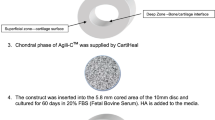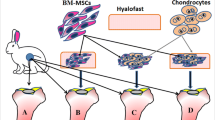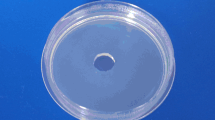Abstract
Purpose
Minced chondral fragments are becoming popular as a source of cells for cartilage repair, as a growing interest is developing towards one-stage procedures to treat cartilage lesions. The purpose of this study is to (A) compare cell outgrowth from cartilage fragments of adult and young donors using two different types of scaffolds and (B) evaluate the influence of transforming-growth-factor-β1 (TGF-β1) and granulocyte colony-stimulating factor (G-CSF) on chondrocyte behaviour.
Methods
In part (A) cartilage fragments from adult and young donors were either loaded onto an HA-derivative injectable paste scaffold or onto an HA-derivative membrane scaffold. Construct sections were then examined for cell counting after 1, 2 and 3 months. In part (B) only membrane scaffolds were prepared using cartilage fragments from young donors. Constructs were cultured either in standard growth medium or in the presence of specific growth factors, such as TGF-β1 or G-CSF or TGF-β1 + G-CSF. After 1 month, construct sections were examined for cell counting. Expression of chondrocyte markers (SOX9, CD151, CD49c) and proliferative markers (β-catenin, PCNA) was assessed using immunofluorescence techniques, both in unstimulated construct sections and in cells from unstimulated and stimulated construct cultures.
Results
Part (A): histological analysis showed age-dependent and time-dependent chondrocyte migration. A significant difference (p < 0.05) was observed between young and older donors at the same time point. No difference was detected between the two types of scaffolds within the same group at the same time point. Part (B): after 1 month, the number of migrating cells/area significantly increased due to exposure to TGF-β1 and/or G-CSF (p < 0.05). Immunofluorescence revealed that outgrowing cells from unstimulated scaffold sections were positive for SOX9, CD151, CD49c and G-CSF receptor. Immunofluorescence of cells from construct cultures showed an increase in β-catenin in all stimulated groups and an increased PCNA expression in G-CSF-exposed cultures (p < 0.05).
Conclusion
Outgrowing cells may represent a subset of chondrocytes undergoing a phenotypic shift towards a proliferative state. TGF-β1, and to a greater extent G-CSF, may accelerate this outgrowth. The clinical relevance of this study may involve a potential future clinical application of scaffolds preloaded with growth factors as an additional coating for chondral fragments. Indeed, a controlled delivery of G-CSF, widely employed in various clinical settings, might improve the repair process driven by minced human cartilage fragments during one-stage cartilage repair.









Similar content being viewed by others
References
Adkisson HD 4th, Martin JA, Amendola RL, Milliman C, Mauch KA, Katwal AB, Seyedin M, Amendola A, Streeter PR, Buckwalter JA (2010) The potential of human allogeneic juvenile chondrocytes for restoration of articular cartilage. Am J Sports Med 38:1324–1333
Albrecht F, Roessner A, Zimmermann E (1983) Closure of osteochondral lesions using chondral fragments and fibrin adhesive. Arch Orthop Trauma Surg 101:213–217
Almqvist KF, Dhollander AAM, Verdonk PCM, Forsyth R, Verdonk R, Verbruggen G (2009) Treatment of cartilage defects in the knee using alginate beads containing human mature allogenic chondrocytes. Am J Sports Med 37:1920–1929
Anderlini P (2009) Effects and safety of granulocyte colony-stimulating factor in healthy volunteers. Curr Opin Hematol 16:35–40
Bonasia DE, Martin JA, Marmotti A, Amendola RL, Buckwalter JA, Rossi R, Blonna D, Adkisson HD 4th, Amendola A (2011) Cocultures of adult and juvenile chondrocytes compared with adult and juvenile chondral fragments: in vitro matrix production. Am J Sports Med 39:2355–2361
Brittberg M, Sjögren-Jansson E, Thornemo M, Faber B, Tarkowski A, Peterson L, Lindahl A (2005) Clonal growth of human articular cartilage and the functional role of the periosteum in chondrogenesis. Osteoarthr Cartil 13:146–153
Buckwalter JA (2002) Articular cartilage injuries. Clin Orthop Relat Res 402:21–37
Buckwalter JA, Mankin HJ (1997) Instructional course lectures, The American Academy of Orthopaedic Surgeons—Articular Cartilage. Part II: degeneration and osteoarthrosis, repair, regeneration, and transplantation. J Bone Joint Surg Am 79:612–632
Buckwalter JA, Mankin HJ, Grodzinsky AJ (2005) Articular cartilage and osteoarthritis. Instr Course Lect 54:465–480
Buckwalter JA, Martin JA, Olmstead M, Athanasiou KA, Rosenwasser MP, Mow VC (2003) Osteochondral repair of primate knee femoral and patellar articular surfaces: implications for preventing post-traumatic osteoarthritis. Iowa Orthop J 23:66–74
Buda R, Vannini F, Cavallo M, Grigolo B, Cenacchi A, Giannini S (2010) Osteochondral lesions of the knee: a new one-step repair technique with bone-marrow-derived cells. J Bone Joint Surg Am 92(Suppl 2):2–11
Burmester GR, Feist E, Sleeman MA, Wang B, White B, Magrini F (2011) Mavrilimumab, a human monoclonal antibody targeting GM-CSF receptor-α, in subjects with rheumatoid arthritis: a randomised, double-blind, placebo-controlled, phase I, first-in-human study. Ann Rheum Dis 70:1542–1549
Buschmann MD, Gluzband YA, Grodzinsky AJ, Kimura JH, Hunziker EB (1992) Chondrocytes in agarose culture synthesize a mechanically functional extracellular matrix. J Orthop Res 10:745–758
Camussi G, Deregibus M-C, Bruno S, Grange C, Fonsato V, Tetta C (2011) Exosome/microvesicle-mediated epigenetic reprogramming of cells. Am J Cancer Res 1:98–110
Choi SH, Park TG (2006) G-CSF loaded biodegradable PLGA nanoparticles prepared by a single oil-in-water emulsion method. Int J Pharm 311:223–228
Cole BJ, Farr J, Winalski CS, Hosea T, Richmond J, Mandelbaum B, De Deyne PG (2011) Outcomes after a single-stage procedure for cell-based cartilage repair: a prospective clinical safety trial with 2-year follow-up. Am J Sports Med 39:1170–1179
Cook AD, Braine EL, Campbell IK, Rich MJ, Hamilton JA (2001) Blockade of collagen-induced arthritis post-onset by antibody to granulocyte-macrophage colony-stimulating factor (GM-CSF): requirement for GM-CSF in the effector phase of disease. Arthritis Res 3:293–298
Cornish AL, Campbell IK, McKenzie BS, Chatfield S, Wicks IP (2009) G-CSF and GM-CSF as therapeutic targets in rheumatoid arthritis. Nat Rev Rheumatol 5:554–559
Dehne T, Karlsson C, Ringe J, Sittinger M, Lindahl A (2009) Chondrogenic differentiation potential of osteoarthritic chondrocytes and their possible use in matrix-associated autologous chondrocyte transplantation. Arthr Res Ther 11:R133
Diaz-Romero J, Gaillard JP, Grogan SP, Nesic D, Trub T, Mainil-Varlet P (2005) Immunophenotypic analysis of human articular chondrocytes: changes in surface markers associated with cell expansion in monolayer culture. J Cell Physiol 202(3):731–742
Dowthwaite GP, Bishop JC, Redman SN, Khan IM, Rooney P, Evans DJR, Haughton L, Bayram Z, Boyer S, Thomson B, Wolfe MS, Archer CW (2004) The surface of articular cartilage contains a progenitor cell population. J Cell Sci 117:889–897
Eyles JL, Roberts AW, Metcalf D, Wicks IP (2006) Granulocyte colony-stimulating factor and neutrophils–forgotten mediators of inflammatory disease. Nat Clin Pract Rheumatol 2:500–510
Farr J, Cole B, Dhawan A, Kercher J, Sherman S (2011) Clinical cartilage restoration: evolution and overview. Clin Orthop Relat Res 469:2696–2705
Farr J, Cole BJ, Sherman S, Karas V (2012) Particulated articular cartilage: CAIS and DeNovo NT. J Knee Surg 25:23–29
Favreau AJ, Sathyanarayana P (2012) miR-590-5p, miR-219-5p, miR-15b and miR-628-5p are commonly regulated by IL-3, GM-CSF and G-CSF in acute myeloid leukemia. Leuk Res 36:334–341
Frisbie DD, Lu Y, Kawcak CE, DiCarlo EF, Binette F, McIlwraith CW (2009) In vivo evaluation of autologous cartilage fragment-loaded scaffolds implanted into equine articular defects and compared with autologous chondrocyte implantation. Am J Sports Med 37(Suppl 1):71S–80S
Giannini S, Buda R, Vannini F, Cavallo M, Grigolo B (2009) One-step bone marrow-derived cell transplantation in talar osteochondral lesions. Clin Orthop Relat Res 467:3307–3320
Giovannini S, Diaz-Romero J, Aigner T, Heini P, Mainil-Varlet P, Nesic D (2010) Micromass co-culture of human articular chondrocytes and human bone marrow mesenchymal stem cells to investigate stable neocartilage tissue formation in vitro. Eur Cell Mater 20:245–259
Gouttenoire J, Valcourt U, Ronzière M-C, Aubert-Foucher E, Mallein-Gerin F, Herbage D (2004) Modulation of collagen synthesis in normal and osteoarthritic cartilage. Biorheology 41:535–542
Ham O, Song B-W, Lee S-Y, Choi E, Cha M-J, Lee CY, Park J-H, Kim I-K, Chang W, Lim S, Lee CH, Kim S, Jang Y, Hwang K-C (2012) The role of microRNA-23b in the differentiation of MSC into chondrocyte by targeting protein kinase A signaling. Biomaterials 33:4500–4501
Hunziker EB (2002) Articular cartilage repair: basic science and clinical progress. A review of the current status and prospects. Osteoarthr Cartil 10:432–463
Ishida K, Matsumoto T, Sasaki K, Mifune Y, Tei K, Kubo S, Matsushita T, Takayama K, Akisue T, Tabata Y, Kurosaka M, Kuroda R (2010) Bone regeneration properties of granulocyte colony-stimulating factor via neovascularization and osteogenesis. Tissue Eng Part A 16:3271–3284
Johnson KA, Rose DM, Terkeltaub RA (2008) Factor XIIIA mobilizes transglutaminase 2 to induce chondrocyte hypertrophic differentiation. J Cell Sci 121:2256–2264
Katano M, Okamoto K, Arito M, Kawakami Y, Kurokawa MS, Suematsu N, Shimada S, Nakamura H, Xiang Y, Masuko K, Nishioka K, Yudoh K, Kato T (2009) Implication of granulocyte-macrophage colony-stimulating factor induced neutrophil gelatinase-associated lipocalin in pathogenesis of rheumatoid arthritis revealed by proteome analysis. Arthr Res Ther 11:R3
Kaygusuz MA, Turan CC, Aydın NE, Temel İ, Fırat S, Bulut T, Kuku İ (2006) The effects of G-CSF and naproxen sodium on the serum TGF-β1 level and fracture healing in rat tibias. Life Sci 80:67–73
Klocke R, Kuhlmann MT, Scobioala S, Schäbitz W-R, Nikol S (2008) Granulocyte colony-stimulating factor (G-CSF) for cardio- and cerebrovascular regenerative applications. Curr Med Chem 15:968–977
Kokkonen H, Söderström I, Rocklöv J, Hallmans G, Lejon K, Rantapää Dahlqvist S (2010) Up-regulation of cytokines and chemokines predates the onset of rheumatoid arthritis. Arthr Rheum 62:383–391
Krinner E-M, Raum T, Petsch S, Bruckmaier S, Schuster I, Petersen L, Cierpka R, Abebe D, Mølhøj M, Wolf A, Sørensen P, Locher M, Baeuerle PA, Hepp J (2007) A human monoclonal IgG1 potently neutralizing the pro-inflammatory cytokine GM-CSF. Mol Immunol 44:916–925
Lawlor KE, Campbell IK, Metcalf D, O’Donnell K, van Nieuwenhuijze A, Roberts AW, Wicks IP (2004) Critical role for granulocyte colony-stimulating factor in inflammatory arthritis. Proc Natl Acad Sci USA 101:11398–11403
Lee MC, Goomer RS, Takahashi K, Harwood FL, Amiel M, Amiel D (2000) Transforming growth factor beta one (TGF-beta 1) enhancement of the chondrocytic phenotype in aged perichondrial cells: an in vitro study. Iowa Orthop J 20:11–16
Lu Y, Dhanaraj S, Wang Z, Bradley DM, Bowman SM, Cole BJ, Binette F (2006) Minced cartilage without cell culture serves as an effective intraoperative cell source for cartilage repair. J Orthop Res 24:1261–1270
Marmotti A, Bruzzone M, Bonasia DE, Castoldi F, Rossi R, Piras L, Maiello A, Realmuto C, Peretti GM (2012) One-step osteochondral repair with cartilage fragments in a composite scaffold. Knee Surg Sports Traumatol Arthrosc. (Epub ahead of print) PubMed PMID: 22349601
Martin JA, Buckwalter JA (2003) The role of chondrocyte senescence in the pathogenesis of osteoarthritis and in limiting cartilage repair. J Bone Joint Surg Am 85-A(Suppl 2):106–110
Meyer PWA, Hodkinson B, Ally M, Musenge E, Wadee AA, Fickl H, Tikly M, Anderson R (2010) Circulating cytokine profiles and their relationships with autoantibodies, acute phase reactants, and disease activity in patients with rheumatoid arthritis. Mediat Inflamm 2010:158514
Mithoefer K, McAdams TR, Scopp JM, Mandelbaum BR (2009) Emerging options for treatment of articular cartilage injury in the athlete. Clin Sports Med 28:25–40
Plater-Zyberk C, Joosten LAB, Helsen MMA, Hepp J, Baeuerle PA, van den Berg WB (2007) GM-CSF neutralisation suppresses inflammation and protects cartilage in acute streptococcal cell wall arthritis of mice. Ann Rheum Dis 66:452–457
Plater-Zyberk C, Joosten LAB, Helsen MMA, Koenders MI, Baeuerle PA, van den Berg WB (2009) Combined blockade of granulocyte-macrophage colony stimulating factor and interleukin 17 pathways potently suppresses chronic destructive arthritis in a tumour necrosis factor alpha-independent mouse model. Ann Rheum Dis 68:721–728
Quintero M, Colantuoni G, Khatib AM, Panasyuk A, Lomri A, Mitrovic DR (2001) Granulocyte-macrophage colony stimulating factor activates proteoglycan, type II collagen, and cAMP production by rat articular chondrocytes through specific binding sites. J Rheumatol 28:2075–2084
Quintero M, Riera H, Colantuoni G, Khatib A-M, Attalah H, Moldovan F, Mitrovic DR, Lomri A (2008) Granulocyte-macrophage colony stimulating factor is anabolic and interleukin-1beta is catabolic for rat articular chondrocytes. Cytokine 44:366–372
Rudert M, Wirth CJ, Schulze M, Reiss G (1998) Synthesis of articular cartilage-like tissue in vitro. Arch Orthop Trauma Surg 117:141–146
Ryu J-H, Kim S-J, Kim S-H, Oh C-D, Hwang S-G, Chun C-H, Oh S-H, Seong J-K, Huh T-L, Chun J-S (2002) Regulation of the chondrocyte phenotype by beta-catenin. Development 129:5541–5550
Salvucci O, Jiang K, Gasperini P, Maric D, Zhu J, Sakakibara S, Espigol-Frigole G, Wang S, Tosato G (2012) MicroRNA126 contributes to G-CSF-induced hematopoietic progenitor cell mobilization by reducing VCAM-1 expression. Haematologica 97(6):818–826
Sandell LJ, Xing X, Franz C, Davies S, Chang L-W, Patra D (2008) Exuberant expression of chemokine genes by adult human articular chondrocytes in response to IL-1beta. Osteoarthr Cartil 16:1560–1571
Sasaki K, Kuroda R, Ishida K, Kubo S, Matsumoto T, Mifune Y, Kinoshita K, Tei K, Akisue T, Tabata Y, Kurosaka M (2008) Enhancement of tendon-bone osteointegration of anterior cruciate ligament graft using granulocyte colony-stimulating factor. Am J Sports Med 36:1519–1527
Saw K-Y, Anz A, Merican S, Tay Y-G, Ragavanaidu K, Jee CSY, McGuire DA (2011) Articular cartilage regeneration with autologous peripheral blood progenitor cells and hyaluronic acid after arthroscopic subchondral drilling: a report of 5 cases with histology. Arthroscopy 27:493–506
Schroeppel JP, Crist JD, Anderson HC, Wang J (2011) Molecular regulation of articular chondrocyte function and its significance in osteoarthritis. Histol Histopathol 26:377–394
Sehgal PB, Mukhopadhyay S, Patel K, Xu F, Almodóvar S, Tuder RM, Flores SC (2009) Golgi dysfunction is a common feature in idiopathic human pulmonary hypertension and vascular lesions in SHIV-nef-infected macaques. Am J Physiol Lung Cell Mol Physiol 297:L729–L737
Singhrao SK, Gilbert SJ, Khan I, Duance VC, Archer CW (2008) TGFβ1 affects the biological responses of primary chondrocytes grown on poly(ethyleneterephthalate)/poly (ε-caprolactone) co-polymer flat scaffolds. Eur Cells Mater 16(Suppl. 3):91
Stephan S, Purcell WM, Chander CL (1999) Granulocyte-colony stimulating factor decreases glycosaminoglycan concentration and increases nitric oxide production in rat articular cartilage. Inflamm Res 48(Suppl 2):S126–S127
Stoop R, Albrecht D, Gaissmaier C, Fritz J, Felka T, Rudert M, Aicher WK (2007) Comparison of marker gene expression in chondrocytes from patients receiving autologous chondrocyte transplantation versus osteoarthritis patients. Arthr Res Ther 9:R60
Strassburg S, Hodson NW, Hill PI, Richardson SM, Hoyland JA (2012) Bi-directional exchange of membrane components occurs during co-culture of mesenchymal stem cells and nucleus pulposus cells. PLoS ONE 7:e33739
Tallheden T, Bengtsson C, Brantsing C, Sjögren-Jansson E, Carlsson L, Peterson L, Brittberg M, Lindahl A (2005) Proliferation and differentiation potential of chondrocytes from osteoarthritic patients. Arthr Res Ther 7:R560–R568
Tang XN, Berman AE, Swanson RA, Yenari MA (2010) Digitally quantifying cerebral hemorrhage using Photoshop and Image J. J Neurosci Methods 190:240–243
Tetta C, Bruno S, Fonsato V, Deregibus MC, Camussi G (2011) The role of microvesicles in tissue repair. Organogenesis 7:105–115
van Dijk CN, Reilingh ML, Zengerink M, van Bergen CJA (2010) The natural history of osteochondral lesions in the ankle. Instr Course Lect 59:375–386
van Holten J, Reedquist K, Sattonet-Roche P, Smeets TJM, Plater-Zyberk C, Vervoordeldonk MJ, Tak PP (2004) Treatment with recombinant interferon-beta reduces inflammation and slows cartilage destruction in the collagen-induced arthritis model of rheumatoid arthritis. Arthr Res Ther 6:R239–R249
Wang G, Yan Q, Woods A, Aubrey LA, Feng Q, Beier F (2011) Inducible nitric oxide synthase-nitric oxide signaling mediates the mitogenic activity of Rac1 during endochondral bone growth. J Cell Sci 124:3405–3413
Yannaki E, Athanasiou E, Xagorari A, Constantinou V, Batsis I, Kaloyannidis P, Proya E, Anagnostopoulos A, Fassas A (2005) G-CSF-primed hematopoietic stem cells or G-CSF per se accelerate recovery and improve survival after liver injury, predominantly by promoting endogenous repair programs. Exp Hematol 33:108–119
Yasuhara R, Ohta Y, Yuasa T, Kondo N, Hoang T, Addya S, Fortina P, Pacifici M, Iwamoto M, Enomoto-Iwamoto M (2011) Roles of β-catenin signaling in phenotypic expression and proliferation of articular cartilage superficial zone cells. Lab Invest 91:1739–1752
Yu C, Chen W-P, Wang X-H (2011) MicroRNA in osteoarthritis. J Int Med Res 39:1–9
Yuan W, Liu Z (2011) Surgical wound healing using hemostatic gauze scaffold loaded with nanoparticles containing sustained-release granulocyte colony-stimulating factor. Int J Nanomedicine 6:3139–3149
Acknowledgments
This work was supported by “DJ ESSKA Ortho Grant 2006” and “CRT (Cassa di Risparmio di Torino)—Alfieri project” (independent research fund). Authors are grateful to FAB (Fidia Advanced Biopolymers s.r.l.) for donation of Hyaff-11 membranes and to Sergio D’Antico, MD, and Paola Manzini, MD, for the help in the preparation of the human PRP. Authors are also grateful to Prof. Paolo Rossi for his precious help in the planning and fulfilment of the study and his continuous encouragement. Authors would also like to thank Radhika Srinivasan, PhD, for editing of the manuscript.
Author information
Authors and Affiliations
Corresponding author
Electronic supplementary material
Below is the link to the electronic supplementary material.


Rights and permissions
About this article
Cite this article
Marmotti, A., Bonasia, D.E., Bruzzone, M. et al. Human cartilage fragments in a composite scaffold for single-stage cartilage repair: an in vitro study of the chondrocyte migration and the influence of TGF-β1 and G-CSF. Knee Surg Sports Traumatol Arthrosc 21, 1819–1833 (2013). https://doi.org/10.1007/s00167-012-2244-7
Received:
Accepted:
Published:
Issue Date:
DOI: https://doi.org/10.1007/s00167-012-2244-7




